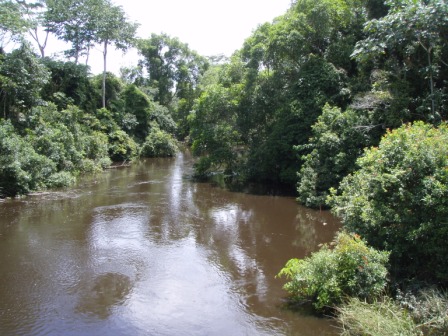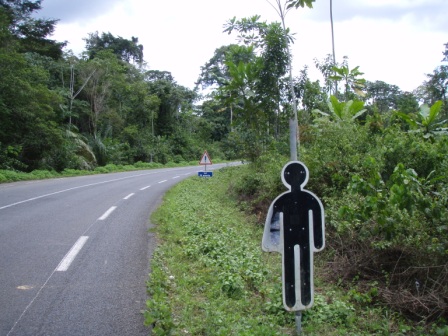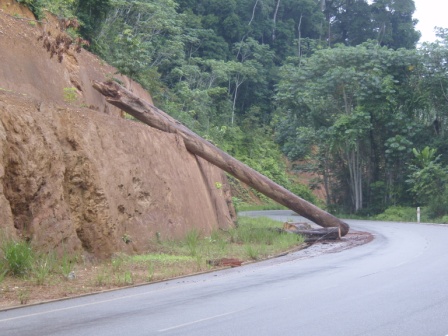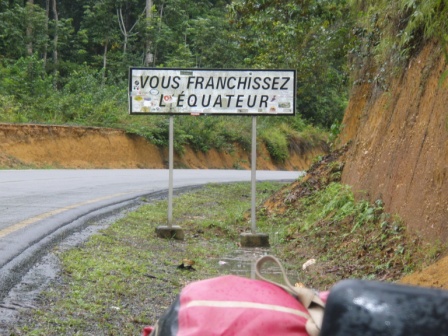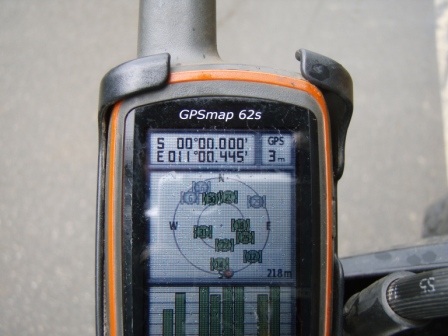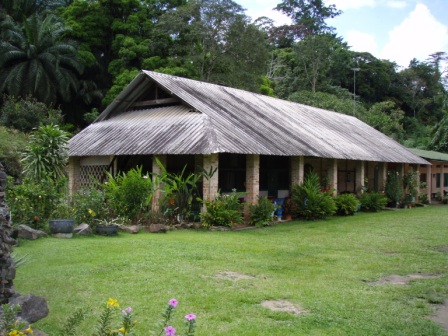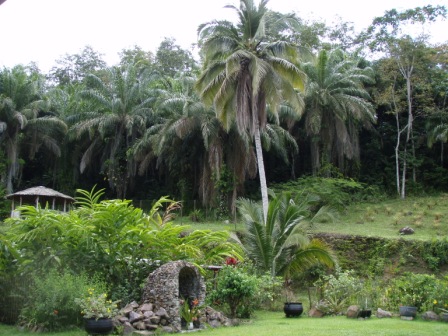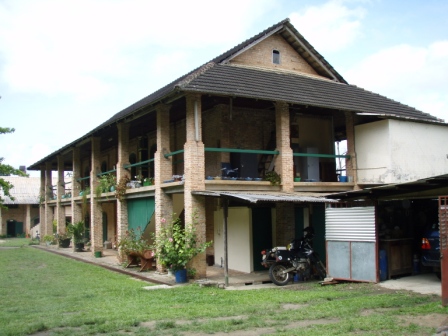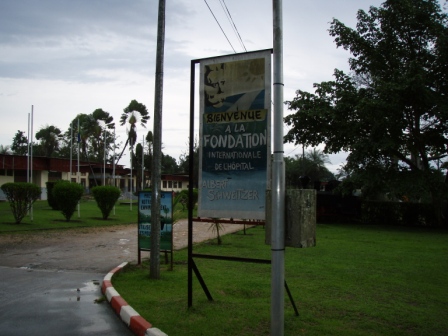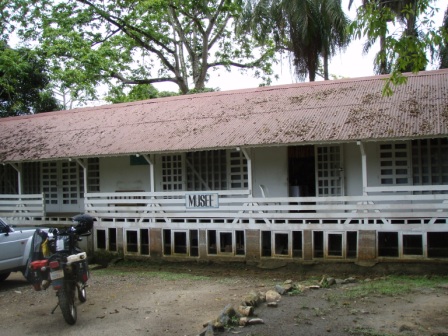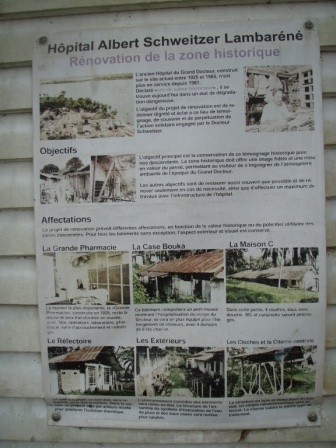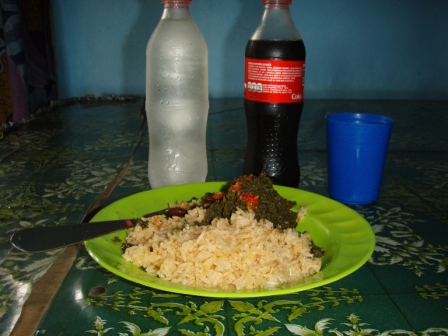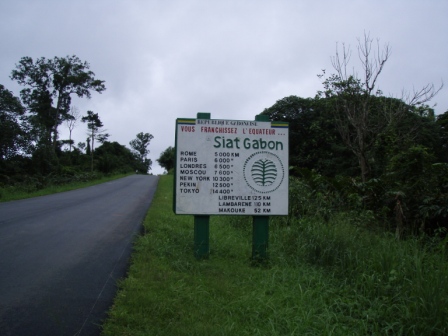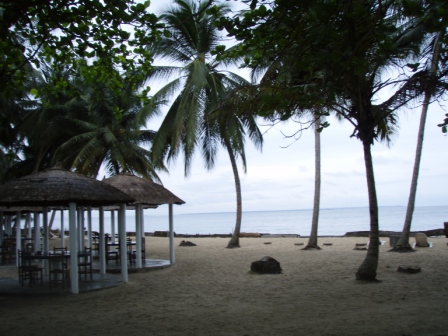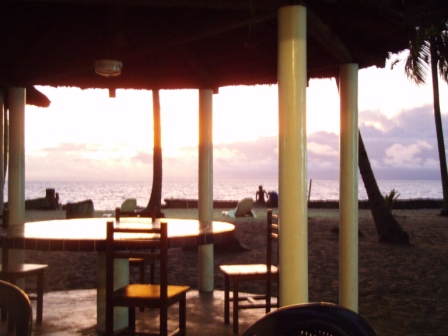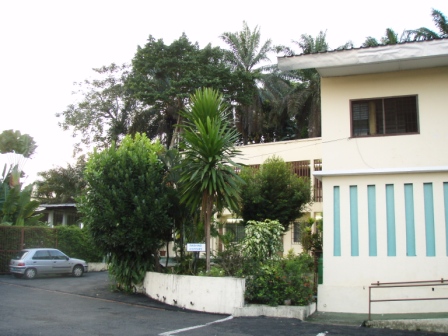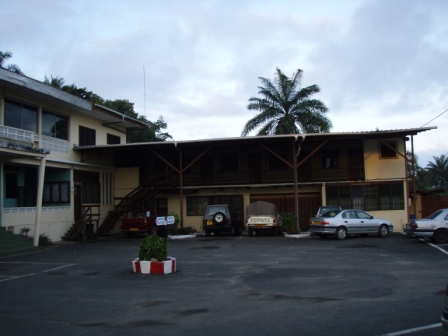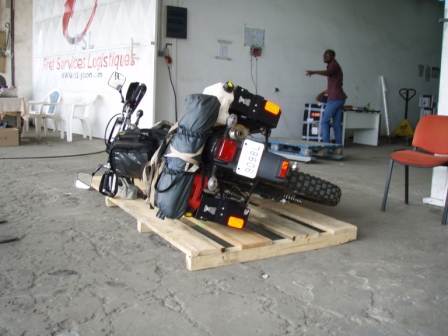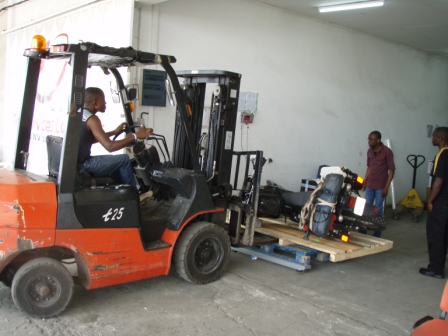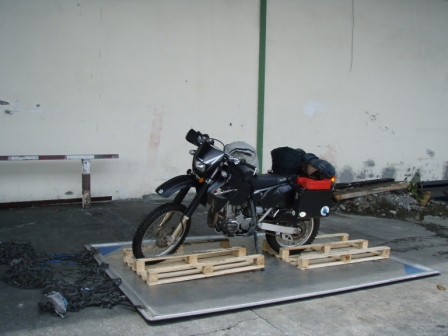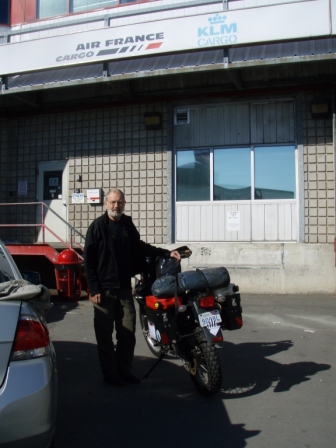Gabon
Almost instantly after crossing into Gabon the rain forest became even more dense, humid and exotic (at least to me). The curvy road through the rolling hills was in excellent condition and a motorcyclists dream. I tried to capture some of this on my GoPro video camera but the result seemed much less interesting. It was missing the closeness of the forest and the dank smells. Once again I was taken back to my childhood watching my first ever movie in a theatre African Queen with Bogart and McCall totally fascinated with the whole notion of traveling on a river through the jungle. So you can tell my impressions of Gabon are not exactly objective. From the perspective of Google Earth, Gabon is one huge green impenetrable carpet of rain forest. It looks pretty much the same from the ground too.
My first impression of Gabon was that this was a much more developed and affluent country than any I have experienced yet on this trip. The homes in the roadside villages were better constructed and often with modest landscaping around them. There were very few motorcycles on the road and the cars were newer and in better condition. I think the driving was a notch or two less crazy as well. Actually there was very little traffic of any kind on the road leading to Lambarene except for the big logging trucks carrying huge trees out of the forest.
Accident scenes and the resulting death count are marked with these signs:
It was a short hop to Oyem a rough and tumble kind of town about 1000 meters above sea level which made for cooler nights. The economy is based on coffee and cocoa which is exported through Cameroon. It has a bit of a shady history. Some Peace Corp volunteers were murdered here in the early 90s then a typhoid outbreak killed a number of residents and a bizarre siege by rabid dogs killed 5 in the town.
All was quiet during my stay except for a loud thunderstorm. It was this storm that determined my hasty selection of a hotel. On closer inspection it was once a nice hotel but maintenance had been allowed to slip a bit. An example would be the string that replaced the bathroom door handle and various items left by previous tenants. But it was dry inside. I have stayed in about 40 hotel rooms so far on this trip and they have all been remarkably different. I couldn't say that about the last 40 hotel rooms I've experienced in North America. Too much sameness in our North American lives because of multinational corporation efficiencies.
The morning found me, bright and early heading south from Oyem in the now persistent rain, and it soon became apparent that logging was a big business here. The trucks would pop out of muddy logging trails all along the highway leaving substantial amounts of red clay on the road.
Sometimes the logs would fall off the trucks on curves.
Around mid-morning I stopped at village that was obviously a sort of hub for the logging truck drivers. Wherever you see a few trucks parked, there is likely a place to get some food and sure enough there was a small crowed restaurant. I sat at one of the long benches shoulder to shoulder with these rough, tough drivers. I say this because it is a very dangerous job anywhere in the world. They must drive these heavily loaded trucks down temporary logging roads cut through the bush without any of the normal safety measures.
To their credit they paid little attention to the old white guy wearing a bright yellow rain suit (it was still raining). I had a delicious omelette and (Nescafe) coffee and absorbed a little insight into the daily life of these guys as we shared the steamy room.
Crossed the Equator.
The road was in good condition and I made good time so by 4:00pm I was crossing the first bridge into Lambarene. The last place of any size before the border with the Republic of Congo (on this southerly route) Lambarene covers the north and south shores and an island in the middle of the mighty Ogooue river all connected by two bridges. The north shore is where Albert Schweitzer (famous Nobel Prize recipient for his work with leprosy victims) established his hospital and research clinic in 1913 that survives today focusing on malaria research.
I chose the Soeurs de la Imacculate Conception mission from my guidebook and it was a good decision. The mission buildings overlooking the river are red brick surrounded by beautifully landscaped gardens. The Sisters like to garden. The hostel is really a few spotlessly clean rooms attached to classrooms for the young children who attend school here.
The Nunnery.
It had a very nice vibe and I enjoyed my 2 day stay there. For almost the only time on this trip, I took a day to do some sightseeing. I went to the Schweitzer hospital, toured the historic grounds along the river and visited the museum. It was great.
Plan to restore original buildings.
I had a tasty lunch at the staff canteen. Manioc "stew" and rice.
Not far south of Lambarene the finished road ends making it tough going especially if it has been raining. This road continues south to Dolisie in the Republic of Congo then heads East to Brazzaville, the capital. This last section is famously difficult.
My personal preference was to take a different route from Ndjole to Franceville on a good gravel road. From Franceville it is just a few kilometres to the Congo border at Lekoni Here the road ends but there is a sandy track to Okoyo then a dirt track to Obouya. This is also considered a difficult route. From Obouya there is a newish paved road the 450km south to Brazzaville.
But for now I was back-tracking for 70km from Lambarene to take the road West to Libreville, the capital of Gabon located on the Bay of Guinea.
Crossed the Equator again on the road to Libreville.
One of the old single lane bridges is still in use.
It was a pleasant ride until about 40km from Libreville when the road went from seriously pot-holed to a heavily traveled construction diversion. It was hot, very dusty and pretty tough going for everyone. However, the moment you reach the marine drive you can see a beautiful beach on one side of the road and a rather modern city on the other.
Oil money gave Gabon a head start over its neighbours years ago and you can see the infrastructure it has built in Libreville The oil is almost exhausted now so Gabon has embraced eco- tourism in a big way. It certainly has the natural resources, the forest, the animals, and the foresight to create national parks that account for 10% of the country.
I stopped at the La Tropicana hotel because it was on the beach and close to the airport.
It was nice to be on the beach but the rooms were pretty shabby and expensive. The restaurant/bar was very good. It seemed to be a favourite of the young French ex-pats. However, the room was only available for 2 nights. Not wanting to be homeless, I went further into town and reserved a room at Maison Liebermann, another Catholic mission with rooms for travelers. The rooms were large and very clean with free wifi for less than half of the cost of La Tropicana (8000CFA).
ML is also referenced in the Lonely Planet guide so I was hoping to perhaps meet some fellow travelers but I was the only tourist during my stay.
Here is a rainy photo of Maison Leibermann from my room.
After a few days in Libreville, I found I liked the city although other than the beach there was not much to see. It was "developed" enough to have a choice of restaurants, supermarkets and even a little strip mall that cater to the middle class Gabon residents. Gabon has a lot to offer a tourist, namely the multiple national parks that boast the best eco-tourism value on the globe for those that can afford the high fees.
I had to start thinking about my options for continuing my trip. My limited experience with unimproved roads so far told me that my chances of getting to Brazzaville by motorcycle on my own while it was still raining every day seemed pretty slim. Also my Angola visa had expired October 9th and I would have to re-apply in Canada. Both of these realities were show stoppers. I could attempt the roads but I was taking a chance of getting stuck (literally) with a long and difficult return trip to Gabon or limited and very expensive bike shipping options.
I pondered the notion of continuing my travels by bus and train. Technically, it would be difficult to separate myself from the motorcycle as I need to be present for customs clearance, etc. And I would much prefer to do that type of traveling with family or friends.
I also assessed my feelings about the trip so far. I was very content! I had accomplished my two main goals by crossing the Sahara and by riding through the equatorial rain forests. But they were not important to me now I had completed them. I had gained much more satisfaction just experiencing the sights and people of the countries I had traveled. My head was full of memories that will last me for the rest of my life. I think I can now, in a small way, understand and assess much better the media reports (I'm a bit of a news junkie) from the region and form my own opinions.
So, I started inquiring about bike shipping from Libreville and within a couple of days had some options although all of them were expensive taken out of the context of the trip. Air France was the only carrier that had flights to Europe and would carry a motorcycle classified as "dangerous goods" Once I had the information making the decision was not difficult. I was missing my family after 2 months on the road and now could not wait to get back.
I took the bike to Air France Cargo next to the Libreville airport and we started the shipping process. First we needed to weigh the bike but they did not have a drive on scale so we needed to lay the bike on its side on a wooden pallet.
Ready to tie down on an air pallet.
After getting the Carnet signed out of Gabon by customs, I walked over to the passenger terminal and waited about 7 hours for my flight via Paris to Toronto. My motorcycle took the same aircraft on both flights so we arrived home together.
Canada customs wanted to do an "agricultural inspection" costing $48.50 before they would release the shipment so collected the bike a day later and rode it to my home. The trip was now officially over.
Some final thoughts:
A number of people apparently believe that a trip like this is very difficult, even a dangerous and daring thing to attempt. I must respectfully disagree. I think the idea of traveling by motorcycle along the West coast of Africa seems exotic because most of us only get negative information about the region from the media or charity fundraising commercials. I don't pay attention to government travel advisories as they are so heavily biased to protect themselves from liability.
The reality is that this is a region that lacks "Western" infrastructure, economic development, human rights, and accountable governance but that makes it different but not "dangerous". 99% of the roads I traveled were paved all-weather roads in varying states of repair. No special skills are needed to drive a vehicle on these roads except the sections I have mentioned earlier. Hotels were available everywhere. Food and water was available everywhere. I didn't need to take my camping equipment but did use it in Europe and Morocco to save money.
The biggest impediment to travel in the region is the necessity to get visas - a lot of visas! Border crossings were surprisingly (to me) professional, computerized and easy. My experience at borders in Latin America last year was very different with obvious corruption and manual processes.
Most importantly, the people along the road I met seemed genuinely interested/amused/confused with the travelling foreigner or they just ignored me. I really never felt any animosity. The lack of tourism in the region also means very few people try to make a living off visitors (helpers, beggars, etc). I believe that most people are busy enough with their own lives not to pay me much attention. They, like all of us, are honest, empathetic, generous and reasonably happy from what I could tell. A goood number of strangers went out of their way to provide directions or assistance along the way without any expectation of payment.
The biggest danger is the same one we have in North America and that is the likelihood of a traffic accident.
The toughest part was specific to motorcycle travel. You are fully exposed to the elements most of the day. Heat, dust, rain, exhaust fumes are what have you tired at the end of the day.
Therefore the benefits far outweighed any difficulties. I took the "easy" route and stopped before it became too challenging. I'll enjoy reading about the true adventurers who tackle the "impassable" roads.
Thank you for your interest.


